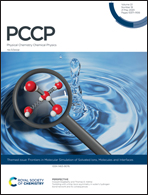Role of specific solute–solvent interactions on the photophysical properties of distyryl substituted BODIPY derivatives†
Abstract
Computational spectroscopy is now a valuable tool to better understand experimental spectroscopic data. Recent advancements in computational methods allow the study of electronic excited states of medium–large molecular systems with greater accuracy, simulating spectra directly comparable with experiments. Besides the system of interest, proper modelling of the environment effects is essential to reach a sufficient level of accuracy. This is especially important for solvents with high polarity or those able to establish specific interactions with the solute. One of the most straightforward and fastest ways to deal with solvent effects is the use of implicit models, like the polarizable continuum model (PCM). However, these models cannot describe specific solute–solvent interactions. In this case, one possible solution is the adoption of a mixed model that includes the solute and few solvent molecules within a PCM cavity. With the aim of investigating the role played by specific solute–solvent interactions, the behaviour of styryl substituted BODIPY systems in methanol has been studied at a theoretical level, considering both implicit and mixed implicit–explicit models. In the first part of our analysis, vibrationally resolved electronic spectra for absorption and emission processes have been simulated, using several sets of coordinates to represent normal modes, and compared with experiments. Then, to verify if specific solute–solvent interactions play a crucial role during the ultrafast intraband relaxation processes, 2D electronic spectra were also simulated, which could provide valuable information on the complex ultrafast dynamics.



 Please wait while we load your content...
Please wait while we load your content...